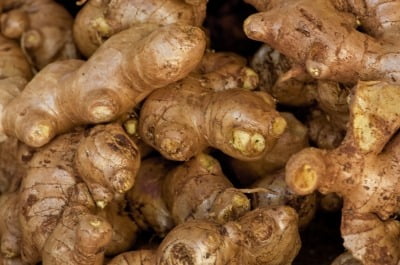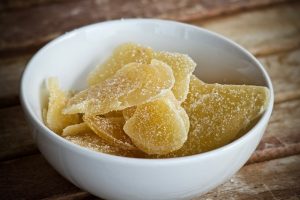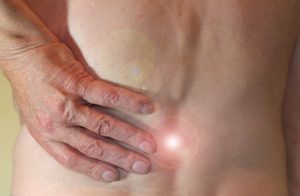
The rhizomes of ginger (Zingiber officinale. Roscoe, family: Zingiberacea) have been used as a traditional home remedy for millenia. It is only in recent years that its many health benefits have been examined. We are all well aware of it being an important contributor to the spice-like heat imparted to curries, beer and is used extensively in Eastern cooking. It is very popular in confectionary, in ginger bread, biscuits, cake and especially sweets. It is estimated that over 100,000 Tonnes of ginger of which 80% is grown in China, is for the culinary market alone.
The health benefits attributed to consumption of ginger range from treating muscular aches and pains, rheumatism, arthritis, cramping, sprains, sore throats, catarrh, high blood pressure (hypertension), stroke, mental disorders including dementia, nervous diseases, fever, infectious diseases, gingivitis and toothache, asthma and diabetes.
However it does not stop there. Ginger is also used to treat various gastric ailments such as “constipation, dyspepsia, belching, bloating, gastritis, epigastric discomfort, gastric ulcerations, indigestion, nausea and vomiting” (Haniadka et al., 2013). A number of scientific studies have validated these ethno-medicinal uses and they continue to create great excitement in the medical world.
The Plant
The plant has a perennial reed-like appearance and produces annual leafy stems to about a metre tall. It is rarely grown outside sub-tropical regions although members of the family are hardy enough to be grown in Europe for example.
Historical Uses For Ginger
Ginger was used throughout the ages to treat sickness with sailors from the East chewing ginger to counteract sea-sickness. The ancient Chinese nearly 2000 years ago always served fish dishes with ginger to reduce the unlucky effects of shellfish poisoning while the ancient Greeks ate ginger sandwiches after large meals to help relieve their indigestion. Over time this practice led to the bread and ginger being made together and eventually being served as ‘gingerbread’.
Ginger is still used for nausea and primarily as a herbal treatment of motion sickness.

Crystallised ginger is always readily available on cruise ships to counter both effects from see sickness and possible food poisoning !
Availability Of Ginger
Please note this page contains links to our affiliate marketing partner. Please read our affiliate disclosure.
Nutritional Information
Fresh ginger root contains the following nutrients in 100 grams (g) based on USDA nutritional information:-
- 79 calories
- 17.86 g of carbohydrate
- 3.57 g of protein
- 3.6 g of dietary fiber
- 14 mg of sodium
- 1.15 g of iron
- 7.7 mg of vitamin C
- 33 mg of potassium
The sugar content is zero !
Other nutrients found in ginger are:
- vitamin B6 (pyridoxine)
- magnesium
- phosphorus
- zinc
- folate
- riboflavin
- niacin
Essential Oils Of Ginger
The main constituents are the volatile oils (zingiberene, curcumene, 1,8-cineole, zingerone, various paradols) an oleoresin (gingerol), and linoleic acid (Govindarajan and Connell, 1983). Early studies on the chemical composition were obtained by hydrodistillation of fresh and dried rhizomes of Nigerian origin (Ekundayo et al., 1988). Assessment relied on a combination of column chromatography, high resolution gas chromatography (GC) and GC-MS. The essential oils were mainly mono- and sesqui-terpenoids of which geranial, neral, 1,8-cineole, zingiberene, β-bisabolene and β-sesquiphellandrene were the major components. Among the 54 constituents identified, (E)(E)-α-farnesene, viridiflorol and (E)(E)-farnesal had not been found previously in ginger (Mahboubi, 2019).
However, the gingerols breakdown during heating and in storage to create the dehydration products, shogaols. These shogaols are the basis of the spice pungency in the ginger oleoresin of dried ginger.
Health Benefits Of Ginger
Gingerol inhibits production of messengers such as nitric oxide and a protector against induced cellular damage (Thomson et al., 2002). There are a number of major reviews on the health benefits of ginger to be consulted (Ali et al., 2008; Kubra et al., 2012), in cancer prevention (Shukla and Singh, 2007) and as an anti-inflammatory (Grzanna et al., 2005). It shares many benefits with another family member, turmeric and it is worth comparing the two for their similar health benefits.
Relieving Arthritis, Joint And Muscle Pains
Ginger has long been used in traditional medicine for treating inflammation and associated conditions. This is mainly for rheumatism in Japanese, Ayurvedic and Chinese medicine, but more recently osteoarthritis in the hip and knee.
Ginger is found to have an anti-inflammatory benefit in rodents but studies on humans has been less forthcoming. It is now widely accepted that consuming it on a regular basis could help reduce the pain and inflammation associated with joint pain and arthritis.

One study, a 6-week double-blind on the osteoarthritis of the knee demonstrated that feeding patients with 255 mg of an extract of Z. officinale and A. galanga twice daily compared to the placebo (Altman and Marcussen, 2001) produced positive effects. There was a reduced need for pain medication in those participants suffering with arthritis.
Not all studies were so conclusive however. A 3-month, three-way crossover double-blind randomised human clinical trial (RCT) compared a ginger extract with ibuprofen and a placebo in a study on hip and knee osteoarthritis but did not demonstrate a difference based on measures of pain (Bliddal et al., 2000).
Studies on human muscle pain also look to show promising benefits (Black et al., 2010; Black & O’Connor, 2010) based on a number of studies conducted at the Department of Kinesiology, Georgia College and State University, Milledgeville, Georgia USA. One study showed that daily consumption of either raw or heat treated ginger produced reasonable and significant reductions in muscle pain. A number of participants (74 in fact) conducted a series of eccentric exercises which caused pain. Consumption of ginger appeared to offer pain relief when consumed. Perhaps what is most intriguing is the effect heating has on the properties of ginger in this regard. Ginger when it has been heat processed improves its hypoalgesic benefits.
A much wider study on the alleviation of pain generally found there is not sufficient evidence to recommend ginger. The situation however is that not enough good quality research has been conducted to support its use. The data so far suggests there is a ‘tentative support’ for the anti-inflammatory role of Z. officinale constituents, which may reduce the subjective experience of pain in some conditions such as osteoarthritis (Terry et al., 2011).
There is also some evidence that consuming ginger reduce the pain associated with the menstrual cycle. The condition of dysmenorrhoea is extremely painful but there is some evidence that the spice helps to alleviate this pain.
Antioxidant Activity
Ginger also possesses high antioxidant activity against lipid peroxidation (Shobana and Naidu, 2000; Halvorsen et al., 2002; Stoilova et al., 2007), and is claimed to reduce atherosclerosis and plasma cholesterol levels (Fuhrman et al., 2000; Thomson et al., 2002). It is also reported to inhibit macrophage activation and its function (Grzanna et al., 2004; Grant and Lutz, 2000). It can also suppress the formation of nitrogen messenger species and even regulate expression of pro-inflammatory genes (Kim et al., 2005). It also inhibited cytokine production and suppressed chemokine production (Phan et al., 2005; Frondoza et al., 2004).
Role In Ameliorating Gastrointestinal Issues: Morning Sickness, Nausea And Vomiting
Nausea and vomiting are severely limiting for anybody in a variety of ways. Ginger has been consumed for centuries to treat a number of conditions associated with vomiting and nausea such as morning sickness, following operations and the effects of anaesthesia, and the results of chemotherapy antiretroviral drug treatment.
Treatment for morning sickness may be one of its best uses. There are at least 12 studies known that show eating giner can reduce nausea. A double-blind, placebo-controlled human intervention study also showed ginger extract was effective at reducing nausea and vomiting during pregnancy (Borrelli et al., 2005; Boone and Shields, 2005). However, it does not stop vomiting.
One of the most recent studies and the first of its kind has shown that ginger can actually prevent the growth of cancer cells as well as induce cell death or apoptosis in prostate cancer cells. The treatment in other studies does not show toxicity to other important normal cells (Karna et al., 2011).
Ginger extracts and their active compounds have been reported to have an ameliorating effect in several animal models of colitis, but there is little information regarding their precise mechanisms of action (Hsiang et al., 2013). Much more study is required to understand whether individual or a mix of components is active in this process. We await with considerable excitement at the prospect of being able to treat such an invidious disease without recourse to surgery.
It is thought that compounds in ginger affect particular receptors, most notably the 5-HT3 receptor.
Ginger And Relief For Chronic Indigestion
A common stomach condition is chronic indigestion or dyspepsia. This is the recurring pain and discomfort felt particularly in the top part of the stomach. Indigestion is thought to be due to a slow or delayed emptying of the stomach into the rest of gut. Ginger is thought to increase the rate of emptying of the stomach and so alleviate the symptoms of dyspepsia. The mechanisms by which it achieves these changes is not fully understood.
In a small study, patients suffering with dyspepsia were given three capsules of ginger (total of 1.2g) or a placebo followed by a soup. Taking ginger appeared to increase the rate of emptying of the stomach from 16 to 12 minutes (Hu et al., 2011). A slightly larger study involving 24 healthy subjects showed that consuming ginger powder (1.2g total) prior to a meal accelerated the emptying of the stomach by at least 50% (Wu et al., 2008).
Ginger And Its Role In Weight Loss And Weight Management

The possibility that consuming ginger might help with losing a bit of weight has some credibility. It is known to raise heat generation in the body which is called thermogenesis. This biochemical process occurs when the body attempts to burn off fat to generate heat as a result of low temperature conditions. Ginger appears to increase the metabolic rate through raised fat metabolism.
Ginger may also be associated with influencing insulin release and moderating its action although much more clinical evidence is required to substantiate such effects.
One study reported in the journal Metabolism found that including small amounts of the spice in a morning meal could reduce hunger pangs and so help manage weight (Mansour et al., 2012). It appears that overweight men drinking a ginger drink in the morning appeared to eat less food later that day, with a feeling of fullness (satiety).
The study conducted at Columbia University and the New York Obesity Research Centre gave ten healthy but overweight men a standard breakfast with ginger ‘tea’. The tea contained 2g of dried powder. The alternative was a similar breakfast but just plain hot water. This was offered on two separate days. The researchers recorded the feelings of hunger immediately before and every hour after taking breakfast. They also measured calories burnt off known as the thermic effect of the food along with a few other key metabolic measures.
Those subjects taking the ‘tea’ burnt off 43 more calories than those drinking hot water. The total resting energy expenditure and the respiratory quotient were not significantly affected. There was no effect on blood glucose levels, triglycerides, insulin or changes to other factors of metabolism.
The research team pointed out that further studies needed on weight control. They concluded that powdered ginger in the diet had a small but significant effect on how food is processed in the body. The ‘tea’ “influenced feelings of satiety without any adverse side effects.”
A more recent study with 80 obese women between the ages of 18 and 45 found that there was also a moderate benefit with consumption of ginger (Attari et al., 2016). Here, the women were either given 2g daily of ginger powder or corn starch in tablet form for 12 weeks. Their body mass index (BMI) and body composition were assessed every 4 weeks along with levels of hormones associated with fat metabolism. Consumption of the ginger powder helped them reduce their BMI, levels of insulin and their resistance to insulin.
The overarching conclusion is that many more larger scale trials are needed to draw stronger, more statistically significant conclusions. However, there is some promise in the findings (Wang et al., 2017).
Diabetes Management
Diabetes is a significant metabolic condition which is increasingly affecting more and more people. As our lifestyles become sedentary and as we become more obese, the liklihood of developing a range of metabolic diseases often linked together as the metabolic syndrome rises. Linked to weight management research is the idea that ginger consumption can also significantly reduce our risk of developing diabetes and minimising its effects if we have the condition (Zhu et al., 2017).
Possible Liver Protecting Role
At the moment studies in rats have shown that the compounds in ginger protect the liver i.e. it has a hepatoprotective effect. The effect needs much wider study but it could help protect against liver cirrhosis (Bardi et al., 2013).
One of the more fascinating aspects to ginger is that its components might also protect us from poisoning including that caused by radiation. Plenty of evidence has been accrued to make a case for using ginger as part of a treatment strategy against the many affects of poisoning in all sorts of forms (Alsherbiny et al., 2019).
Cautionary Information
- If the causes of nausea are not immediately obvious and last for more than a day you should consult a medical professional
- Only use in week amounts and for a short period if pregnant or nursing
- Do not give to any child under two years old
General Note
Please note that the health benefits listed in the article are for public benefit and are general guidelines. Please take professional medical advice or consult a dietician when making changes to your diet.
References
Abdulaziz Bardi, D., Halabi, M. F., Abdullah, N. A., Rouhollahi, E., Hajrezaie, M., & Abdulla, M. A. (2013). In vivo evaluation of ethanolic extract of Zingiber officinale rhizomes for its protective effect against liver cirrhosis. BioMed Research International, 2013.
Ali, B.H., Blunden G., Tanira, M.O., Nemmar, A. (2008) Some phytochemical, pharmacological and toxicological properties of ginger (Zingiber officinale Roscoe): a review of recent research. Food Chem Toxicol. 46 pp. 409–420
Alsherbiny, M. A., Abd-Elsalam, W. H., Taher, E., Fares, M., Torres, A., Chang, D., & Li, C. G. (2018). Ameliorative and protective effects of ginger and its main constituents against natural, chemical and radiation-induced toxicities: A comprehensive review. Food and Chemical Toxicology. (Article)
Altman, R.D., Marcussen, K.C. (2001) Effects of a ginger extract on knee pain in patients with osteoarthritis. Arthritis Rheum. 44 pp. 2531-2538 (Article)
Attari, V. E., Ostadrahimi, A., Jafarabadi, M. A., Mehralizadeh, S., & Mahluji, S. (2016). Changes of serum adipocytokines and body weight following Zingiber officinale supplementation in obese women: a RCT. European Journal of Nutrition, 55(6), pp. 2129-2136. .
Black, C.D., Herring, M.P., Hurley, D.J. O’Connor, P.J. (2010) Ginger (Zingiber officinale) reduces muscle pain caused by eccentric exercise. J. Pain 11(9) pp. 894-903 (Article)
_______., O’Connor, P.J. (2010) Acute Effects of dietary ginger on muscle pain induced by eccentric exercise. Phytother. Res. 24(11) pp. 1620-6 (Article)
Bliddal, H., Rosetzsky, A., Schlichting, P., Weidner, M.S., Andersen, L.A., Ibfelt, H.H., Christensen, K., Jensen, O.N., Barslev, J. (2000) A randomized, placebo-controlled, cross-over study of ginger extracts and ibuprofen in osteoarthritis. Osteoarthritis Cartilage 8 pp. 9-12
, . (2005) Treating pregnancy-related nausea and vomiting with ginger. Ann. Pharmacother. 39 pp. 1710–3.
Borrelli, F., Capasso, R., Aviello, G., Pittler, M.H., Izzo, A.A. (2005) Effectiveness and safety of ginger in the treatment of pregnancy-induced nausea and vomiting. Obstet. Gynecol. 105(4) pp.849-56.
Ekundayo, O., Laakso, I. and Hiltunen, R. (1988), Composition of ginger (Zingiber officinale roscoe) volatile oils from Nigeria. Flavour Fragr. J., 3 pp. 85–90 (Article).
Frondoza, C.G., Sohrabi, A., Polotsky, A., Phan, P.V., Hungerford, D.S., Lindmark, L. (2004) An in vitro screening assay for inhibitors of proinflammatory mediators in herbal extracts using human synoviocyte cultures. In Vitro Cell Dev. Biol. Anim. 40 pp. 95-101.
Fuhrman B, Rosenblat M, Hayek T, Coleman R, Aviram M. (2000) Ginger extract consumption reduces plasma cholesterol, inhibits LDL oxidation and attenuates development of atherosclerosis in atherosclerotic, apolipoprotein E-deficient mice. J. Nutr. 130 pp.1124
Govindarajan, V.S. and Connell, D.W. (1983a) Ginger—chemistry, technology, and quality evaluation: part 1. Critical Reviews in Food Science and Nutrition, vol. 17, no. 1, pp. 1–96
_______________________________ (1983b) Ginger—chemistry, technology, and quality evaluation: part 1. Critical Reviews in Food Science and Nutrition, vol. 17, no. 3, pp. 189–258
Grant, K.L., Lutz, R.B. (2000) Ginger. Am. J. Health Syst. Pharm. 57 pp. 945-947.
Grzanna, R., Phan, P., Polotsky, A., Lindmark, L., Frondoza, C.G. (2004) Ginger extract inhibits beta-amyloid peptide-induced cytokine and chemokine expression in cultured THP-1 monocytes. J. Altern. Complement Med. 10 pp. 1009-1013.
Halvorsen, B.L., Holte, K., Myhrstad, M.C.W., et al. (2002) A systematic screening of total antioxidants in dietary plants. J. Nutr. 132 pp. 461–71
Haniadka, R., Saldanha, E., Sunita, V., Palatty, P. L., Fayad, R., & Baliga, M. S. (2013). A review of the gastroprotective effects of ginger (Zingiber officinale Roscoe). Food & Function, 4(6), pp. 845-855.
, , , , , . (2013) Ginger extract and zingerone ameliorated trinitrobenzene sulphonic acid-induced colitis in mice via modulation of nuclear factor-kappa B activity and interleukin-1β signalling pathway. Food Chem. 136 pp. 170–7
Hu, M. L., Rayner, C. K., Wu, K. L., Chuah, S. K., Tai, W. C., Chou, Y. P., … & Hu, T. H. (2011). Effect of ginger on gastric motility and symptoms of functional dyspepsia.World Journal of Gastroenterology: WJG, 17(1), 105 (Article). .
Grzanna, R., Lindmark, L., Frondoza, C.G., (2005) Ginger – an herbal medicinal product with broad anti-inflammatory actions. J. Med. Food 8, pp. 125–132.
Karna P, Chagani S, Gundala SR, Rida PC, Asif G, Sharma V, Gupta MV, Aneja R (2011) Benefits of whole ginger extract in prostate cancer. Br. J. Nutr. Pp. 1-12 Published online ahead of print, doi: 10.1017/S0007114511003308
Kim, H.W., Murakami, A., Abe, M., Ozawa, Y., Morimitsu, Y., Williams, M.V., Ohigashi, H. (2005) Suppressive effects of mioga ginger and ginger constituents on reactive oxygen and nitrogen species generation, and the expression of inducible pro-inflammatory genes in macrophages. Antioxid. Redox. Signal 7 pp. 1621-1629
Kubra, I. R.; Rao, L. J. (2012) An impression on current developments in the technology, chemistry, and biological activities of ginger (Zingiber officinale Roscoe). Crit. Rev. Food Sci. Nutr. 52, pp. 651−88
Mahboubi, M. (2019). Zingiber officinale Rosc. essential oil, a review on its composition and bioactivity. Clinical Phytoscience, 5(1), 6. (Article)
Mansour, M. S., Ni, Y. M., Roberts, A. L., Kelleman, M., RoyChoudhury, A., & St-Onge, M. P. (2012). Ginger consumption enhances the thermic effect of food and promotes feelings of satiety without affecting metabolic and hormonal parameters in overweight men: a pilot study. Metabolism, 61(10), pp. 1347-1352.
Phan, P.V., Sohrabi, A., Polotsky, A., Hungerford, D.S., Lindmark, L., Frondoza, C.G. (2005) Ginger extract components suppress induction of chemokine expression in human synoviocytes. J. Altern. Complement Med. 11 pp.149-154
Shobana, S., Naidu, K.A. (2000) Antioxidant activity of selected Indian spices. Prostaglandins Leukot. Essent. Fatty Acids 62 pp.107–10.
Shukla, Y., Singh, M. (2006) Cancer preventive properties of ginger: A brief review. Food Chem Toxicol 45(5) pp. 683-690
Stoilova, I., Krastanov, A., Stoyanova, A., Denev, P., & Gargova, S. (2007). Antioxidant activity of a ginger extract (Zingiber officinale). Food Chemistry 102(3) pp. 764–770 (Article)
Terry, R., Posadzki, P., Watson, L.K., Ernst, E. (2011) The use of ginger (Zingiber officinale) for the treatment of pain: a systematic review of clinical trials. pain med., 12(12) pp. 1808-18 .
Thomson, M., Al-Qattan, K.K., Al-Sawan, S.M., Alnaqeeb, M.A., Khan, I., Ali, M., (2002) The use of ginger (Zingiber officinale Rosc.) as a potential anti-inflammatory and antithrombotic agent. Prostaglandins Leukot. Essent. Fatty Acid 67, pp. 475–478
Wang, J., Ke, W., Bao, R., Hu, X., & Chen, F. (2017). Beneficial effects of ginger Zingiber officinale Roscoe on obesity and metabolic syndrome: a review. Annals of the New York Academy of Sciences, 1398(1), pp. 83-98.
Wu, K. L., Rayner, C. K., Chuah, S. K., Changchien, C. S., Lu, S. N., Chiu, Y. C., … & Lee, C. M. (2008). Effects of ginger on gastric emptying and motility in healthy humans. European Journal of Gastroenterology & Hepatology, 20(5), pp. 436-440. (Article)
Zhu, J., Chen, H., Song, Z., Wang, X., & Sun, Z. (2018). Effects of ginger (Zingiber officinale Roscoe) on type 2 diabetes mellitus and components of the metabolic syndrome: A systematic review and meta-analysis of randomized controlled trials. Evidence-Based Complementary and Alternative Medicine. (Article)

Leave a Reply